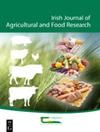培育具有畜牧生产潜力的多年生黑麦草品种的机遇与挑战
IF 1.4
4区 农林科学
Q3 AGRICULTURE, MULTIDISCIPLINARY
引用次数: 2
摘要
本文综述了影响养分能量从初级生产草地向反刍动物奶和肉有效转移的关键因素和障碍。该审查侧重于永久性改良草地,定义为“通过草对草的更新保持高生产潜力的草地”,通常有5至10年的寿命。研究了迄今为止的育种进展,作为下一代栽培品种的主要目标。这包括在三个主要方面使草生产力与反刍动物的需求保持一致,即摄入潜力、营养价值和生产力状况。评估了有选择地改善影响草叶结构、化学成分、季节性和在农场条件下持续和表现能力的植物性状的机会。欧盟环境涉及评估变量的影响,如草的种类和品种,区域非生物压力(水,温度,养分,土壤类型等),疾病和害虫的生物压力,草地管理策略的区域多样性,以及最小化反刍动物养殖的环境足迹的机会。本文章由计算机程序翻译,如有差异,请以英文原文为准。
Opportunities and challenges for breeding perennial ryegrass cultivars with improved livestock production potential
This review addresses key factors and impediments that govern the efficient transfer of nutrient energy from primary producing grassland to ruminant milk and meat. The review focuses on permanent improved grasslands, defined as “swards maintained at a high production potential by grass-to-grass renewal”, frequently of a 5- to 10-yr longevity. Breeding progress to date is examined as are the primary objectives for the next generation of cultivars. This involves aligning grass productivity to ruminant demand in three primary aspects, namely intake potential, nutritional value and productivity profile. The opportunity to selectively improve plant traits affecting sward structure, chemical composition, seasonality and ability to persist and perform under farm conditions is evaluated. The EU context involves appraising the impact of variables such as grass species and cultivar, regional abiotic stresses (water, temperature, nutrients, soil type, etc.), biotic stresses from disease and pests, regional diversity in sward management strategies, and the opportunity to minimise the environmental footprint of ruminant farming.
求助全文
通过发布文献求助,成功后即可免费获取论文全文。
去求助
来源期刊
CiteScore
2.50
自引率
20.00%
发文量
23
审稿时长
>36 weeks
期刊介绍:
The Irish Journal of Agricultural and Food Research is a peer reviewed open access scientific journal published by Teagasc (Agriculture and Food Development Authority, Ireland). Manuscripts on any aspect of research of direct relevance to Irish agriculture and food production, including plant and animal sciences, food science, agri environmental science, soils, engineering, buildings, economics and sociology, will be considered for publication. The work must demonstrate novelty and relevance to the field of research. Papers published or offered for publication elsewhere will not be considered, but the publication of an abstract does not preclude the publication of the full paper in this journal.

 求助内容:
求助内容: 应助结果提醒方式:
应助结果提醒方式:


